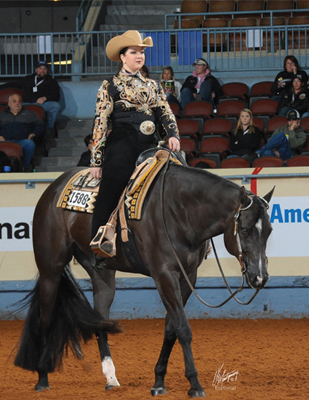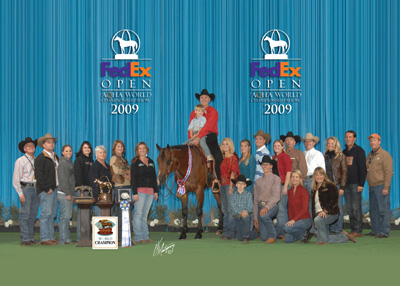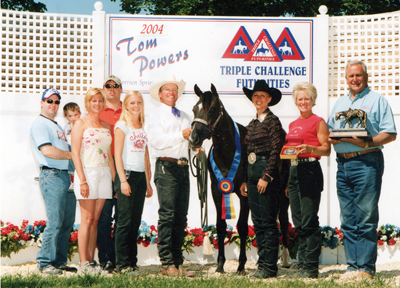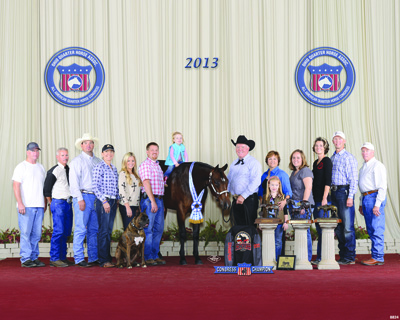 Have you ever heard someone say, horses that have been shown in Longe Line don’t make it under saddle? Most likely you have because it has been at the center of a great debate about the class for years now. In the fourth and final installment of our in-depth series on Longe Line, we seek veterinary advice on the effects of over longing a young horse. We ask trainers and exhibitors to discuss why misconceptions surrounding the class exist and to share their experiences with riding horses who were shown on the line.
Have you ever heard someone say, horses that have been shown in Longe Line don’t make it under saddle? Most likely you have because it has been at the center of a great debate about the class for years now. In the fourth and final installment of our in-depth series on Longe Line, we seek veterinary advice on the effects of over longing a young horse. We ask trainers and exhibitors to discuss why misconceptions surrounding the class exist and to share their experiences with riding horses who were shown on the line.
Longe Line Done Right
Bruce Walquist, Cleburne, Texas, a long-time American Quarter Horse Association, National Snaffle Bit Association and World Conformation Horse Association judge and multiple World Champion trainer, says he feels the misconception that horses that were exhibited in Longe Line classes would not go on to ride took root because for awhile conformation was really being overlooked in the class.
“At one time, I think as judges we were overlooking conformation factors in the Longe Line class and picking the real lightweight, softer moving horses,” Walquist says. “A lot of these horses just did not have enough substance to go on to make good strong horses under saddle.”
When preparing his horses for Longe Line classes, Walquist believes in not overworking them. He believes “too much is bad in anything you do.”
“We get them started and broke to longe but we don’t keep longing over and over,” Walquist says. “I think a lot of amateurs especially tend to overwork their yearlings for their own sake. After we get them broke, we do other things with them like ponying and turning them out for exercise so they stay fresh on the line.”
Russ Smith, Whitesboro, Texas, who is also an AQHA, NSBA and WCHA judge and is a long-time successful trainer and exhibitor of Longe Line horses believes in having a set plan for his yearlings which involves only choosing a few shows a year in which to show.
“Showing every weekend can really tire your yearling out,” Smith says. “I try to pick a couple of main shows a year to target. I try to be very careful with them and not over show them.”
 When training Smith tries not to “over longe” his yearlings. Once he gets them broke to the line, he believes in mixing up the training with turn out and ponying.
When training Smith tries not to “over longe” his yearlings. Once he gets them broke to the line, he believes in mixing up the training with turn out and ponying.
“Once they are well started, I may go back a few times a week and work for a short time on the line to remind them but I really try not to overdo it,” Smith
says. “I want them to like it. I have found horses that I have shown in the program are very simple to break to ride.”
Successful Longe Line trainer, Robin Gollehon of Versailles, Kentucky sees many benefits to showing in the Longe Line. First, she explains it gives breeders an opportunity to showcase their stock and then it gives them a platform to sell a prospect. Also, Longe Line is an entry level class for someone wanting to get into or back into showing and through the Longe Line horses learn how to move before a rider gets on their back, building up strength and stamina. They also get used to the stress of hauling to shows at an early age and have an opportunity to see the sights at the shows as well.
“I agree that some longe liners can be more difficult to ride but not because they were longe lined but because they were longe lined improperly,” Gollehon says. “When done right, longe liners are much further ahead. They already know how to move like a pleasure horse before a rider gets on their back. They’re in better physical condition which will prevent soreness or injury when started under saddle and mentally they are ready for life under saddle because it’s just another step along the way.”
 Long-time horse trainer, NSBA judge and Longe Line exhibitor, Shorty Parks of Emmis, Texas stresses the importance of not overworking yearlings. He believes bringing a yearling along is a lot like getting a 2 or 3-year-old ready for futurities because they are all young horses who can benefit from good ground work.
Long-time horse trainer, NSBA judge and Longe Line exhibitor, Shorty Parks of Emmis, Texas stresses the importance of not overworking yearlings. He believes bringing a yearling along is a lot like getting a 2 or 3-year-old ready for futurities because they are all young horses who can benefit from good ground work.
“I think you need to just spend some time with them,” Parks says. “There are a lot of longe liners that have gone on to be famous horses. I think you need to be smart about training them just like starting a young horse riding. It is also important to try to pick natural movers for the class.”
The Physical Impact
Dr. James Hassinger DVM, Aberdeen, North Carolina is a graduate of North Carolina State University and Auburn University School of Veterinary Medicine who has actively practiced veterinary medicine for 31 years. In 2003, he opened Hassinger Equine Service where he focuses on sports medicine and performance centered practice which is dedicated to equine lameness, performance management, rehabilitation and imaging. In addition, Dr. Hassinger is an active rider at Hassinger Farm and shows primarily on the East Coast.
According to Dr. Hassinger, negative effects from longing do not actually have to do with the size of the horse but rather how the horse is longed.
“It really isn’t about the amount of weight the horse carries but more how they act on the line,” Hassinger says. “As long as it is slow and controlled exercise it can be beneficial to help strengthen and act as a fitness tool. We recommend ponying or riding over longing because many people allow the horses to run hard, buck and play which leads to injuries.”
Mostly, Dr. Hassinger recommends ponying over longing because the speed is more controlled and the horses are exercising in mostly straight lines. He has however not seen any yearlings who have competed in the Longe Line for lameness.
“No we do not see any yearlings for lameness,” Hassinger says. “Our thoughts are that if they do get injured they are turned out and replaced as they do not have that much time and money in training yet.”
 Life After Longe Line
Life After Longe Line
Highly successful Longe Line trainer, Kathie Kennedy, Reddick, Florida, says she believes the Longe Line program can be beneficial to horses in their later training under saddle if done properly.
“I have been very fortunate in this industry over the past 10 years and some of my best yearlings have become great show horses who have won some of the biggest futurities as 2-year-olds in the country,” Kennedy says. “I am glad that they did go through a Longe Line program. If done properly, it is a great foundation for their later years and gives an outlet to market prospects.”
Besides having a future in the Western Pleasure or the Hunter Under Saddle, Kennedy feels the Longe Line can establish a good foundation for horses who will go on to do other events as well.
Some of Kennedy’s favorite Longe Line horses have gone on to have successful show careers in later years. Like Hubba Hubba Huntin by Huntin For Chocolate who won over $10,500 in Longe Line competition and has gone to win Congress and NSBA World Championships in Western Riding. He ended 2009 the AQHA Reserve All-Around Junior Horse and AQHA Green Trail High Point. In addition, Hubba has become a top producer of performance horses.
“Hubba Hubba Huntin will remain one of my favorites of all time. He had a mind and movement that everyone liked and you could tell he was going to be a great breeding horse,” Kennedy says. “At His Best, a 2007 brown stallion that I won the Congress with in the Open Longe Line in 2008 went on to win an NSBA Honor Roll title in the Green Western Pleasure. Of course, Best Ticket N Town by RL Best of Sudden out of Troubles A Blazin that I won the Open Western Longe Line at the 2012 Congress came back in 2013 to win the Open and Non-Pro 2-Year-Old Western Pleasure at A Little Futurity and won the Non-Pro 2-Year-Old Western Pleasure at the Tom Powers Futurity with Nancy Ditty.”
Some of Kennedy’s Longe Line horses have been raised by Haylo Farm in Ocala, Florida owned by Stanley and Susan Scott. Stanley, who is the Equi-Stat all-time leading Longe Line exhibitor in money earned shares Kennedy’s perspective on the class.
“If handled and treated the right way, there have been many later Congress, World and futurity champions from the program,” Scott says. “Yearlings are handled and exposed to more shows at an early age. Only if they are mishandled and not taken care of, those are the yearlings who won’t go on and become good show horses. As more yearlings have become great show horses, more people have been watching, buying and participating in the class.”
 Successful Non-Pro Longe Line exhibitor, Pete Mead, Washington, Indiana, has found only positive benefits from showing his youngsters in Longe Line.
Successful Non-Pro Longe Line exhibitor, Pete Mead, Washington, Indiana, has found only positive benefits from showing his youngsters in Longe Line.
“I think we should try to convince people that it is a good class for their yearlings because it teaches the horse about being at shows and also it is easier for your trainer because the horse already knows cues for stop, walk, trot and lope,” he says.
Through the years Mead has found participating in the Longe Line classes has helped better market his horses.
“Some trainers say that longe liners won’t ride but I believe that it doesn’t have anything to do with the success of riding,” Mead says. “Longe Line definitely helps to get horses started to get broke.”
In fact, Mead’s 2011 Congress Western Longe Line Champion that he showed himself against the open exhibitors, Hez Plum Poison, has gone on to have a successful show career for new owner Olivia Hoecker. This year he was won Circuit Championships at many major shows in Junior Western Pleasure like the Florida Gold and Gulf Coast Circuits with trainer Josh Robertson. He is currently qualified for the AQHA World Show in Junior Western Pleasure.
 Gord Wadds of Ovid, Michigan has found through his many years as a successful Longe Line trainer and exhibitor that showing in the Longe Line program has proved to be a solid beginning for his young horses.
Gord Wadds of Ovid, Michigan has found through his many years as a successful Longe Line trainer and exhibitor that showing in the Longe Line program has proved to be a solid beginning for his young horses.
“It is an advantage to 2-year-old horses being started under saddle that have been shown in Longe Line classes if it suited the individual,” Wadds says.
Many of the horses Wadds has been successful with in Longe Line competition have gone on to do well under saddle including perhaps one of the greatest show horses that ever lived, 14-time AQHA World Champion Western Pleasure horse, A Certain Vino who won over $11,600 on the line.
“The phenomenal black gelding, A Certain Vino first loped his way to stardom being introduced to the show ring by me at the Tom Powers Futurity in 2004 where he was the unanimous champion,” Wadds says.
Vino’s breeder and then owner, Lou Petty of Ocala, Florida recalls Vino’s first days in competition.
“We showed him first in the Longe Line,” Petty says. “I can’t say enough good things about that program. It really helped him get started right.”
Some other examples of great horses that Wadds has experienced on the line include one of the country’s leading Western Pleasure stallions, No Doubt Im Lazy who was bred and raised by Gord with partners Lisa and David Blaszak. No Doubt Im Lazy who was the Tom Powers Champion in Open Longe Line shown by Bill Rinzema went on to be the AQHA World Champion in 2-year-old Western Pleasure shown by Mitch Leckey and won over $7,400 in Longe Line competition. Another highlight in his career is Krymsun N Gold who won most of the major Longe Line events compiling a total of over $8,200 in Longe Line competition. He later went on to be an NSBA World Champion and Superior Western Pleasure horse. Wadds is now preparing offspring of Krymsun N Gold under saddle who also have had successful Longe Line careers.
 There are many horses that appear on the Equi-Stat List of Top Earning Longe Line money that have recorded success under saddle as well. Besides the horses discussed by our Longe Line experts, some other noteworthy horses are: Go Figer the all-time leading Longe Line horse with earnings in excess of $32,300 in Longe Line competition came back the very next year to win the Open and Non-Pro 2-Year-Old Western Pleasure at the 2009 Tom Powers; Inviting Rumors won $20,000 on the line and later finished third in Senior Western Pleasure at the Quarter Horse Congress; Boom Shock Alocka won over $19,300 in Longe Line and won the 2-Year-Old Non-Pro Western Pleasure at the Tom Powers and later became an AQHA Superior Western Pleasure horse; Sheiks Miss Jazimitaz won over $9,000 on the line and went on to be the 2007 Congress 3-Year-Old Limited Open Western Pleasure Reserve Champion, NSBA Reserve World Champion in 3-Year-Old Limited Non-Pro Western Pleasure, 2007 Southern Belle Breeders 3-Year-Old Open Western Pleasure Reserve Champion and is still showing today with over 100 AQHA Performance Points; Cool Krymsun Lady who was the 2009 AQHA World Champion in 2-Year-Old Western Pleasure, multiple Congress Champion and Select Amateur World Champion in Performance Halter Mares earned over $7,000 in the Longe Line; and Willy Has Potential won over $7,300 on the line and went on to finish seventh at the AQHA World Show in Junior Hunter Under Saddle, was a Congress Champion in Novice Amateur Hunter Under Saddle and a NSBA World Champion.
There are many horses that appear on the Equi-Stat List of Top Earning Longe Line money that have recorded success under saddle as well. Besides the horses discussed by our Longe Line experts, some other noteworthy horses are: Go Figer the all-time leading Longe Line horse with earnings in excess of $32,300 in Longe Line competition came back the very next year to win the Open and Non-Pro 2-Year-Old Western Pleasure at the 2009 Tom Powers; Inviting Rumors won $20,000 on the line and later finished third in Senior Western Pleasure at the Quarter Horse Congress; Boom Shock Alocka won over $19,300 in Longe Line and won the 2-Year-Old Non-Pro Western Pleasure at the Tom Powers and later became an AQHA Superior Western Pleasure horse; Sheiks Miss Jazimitaz won over $9,000 on the line and went on to be the 2007 Congress 3-Year-Old Limited Open Western Pleasure Reserve Champion, NSBA Reserve World Champion in 3-Year-Old Limited Non-Pro Western Pleasure, 2007 Southern Belle Breeders 3-Year-Old Open Western Pleasure Reserve Champion and is still showing today with over 100 AQHA Performance Points; Cool Krymsun Lady who was the 2009 AQHA World Champion in 2-Year-Old Western Pleasure, multiple Congress Champion and Select Amateur World Champion in Performance Halter Mares earned over $7,000 in the Longe Line; and Willy Has Potential won over $7,300 on the line and went on to finish seventh at the AQHA World Show in Junior Hunter Under Saddle, was a Congress Champion in Novice Amateur Hunter Under Saddle and a NSBA World Champion.
Lynn Campbell, Pittsboro, Indiana, has found in her experiences that showing in Longe Line has helped make her horses better down the road.
“For the colt its really giving them a chance to see the world and use their best behaviors away from home. I truly believe it will make the riding and training process much easier for them as well,” Campbell says. “Any bad habits horses learn as youngster typically carry on to their older life. If we can get them to be respectful, willing partners as yearlings those that go on to ride them should find their jobs much easier and ahead of the untouched 2 and 3-year-olds.”
All in and all, Campbell believes misconceptions surrounding the class have declined because there have been so many horses make good riders after their Longe Line days.


You must be logged in to post a comment Login